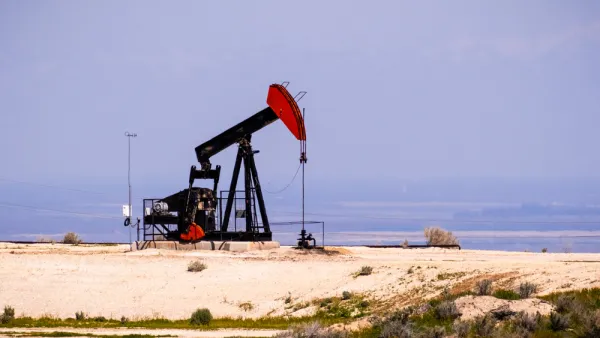As climate hawks gather in San Francisco for the Global Climate Action Summit that convenes Wednesday, Gov. Jerry Brown, host of the summit, is dogged by critics who can't distinguish between oil production and consumption.
We've been here before. Anti-fracking activists charge Gov. Jerry Brown (D-Calif.), who just Saturday signed legislation to block new federal offshore oil drilling along California’s coast, with environmental hypocrisy for hosting the Global Climate Action Summit* in the nation’s sixth-largest oil-producing state, writes Julie Cart, environmental reporter for CALmatters, a Sacramento-based nonpartisan, nonprofit journalism venture.
Their message: The California governor, widely known as a climate defender, is in fact a climate offender. He should ban fracking in California, stop issuing oil-drilling permits and find a way to wean the state off fossil fuels, his critics say. Now.
Planetizen covered Brown's response to the keep it in the ground movement a year ago in an article by John Wildermuth of the San Francisco Chronicle on May 16, 2017:
“As we bring down consumption, we can bring down production,” the governor said, but since California residents now drive about 330 billion miles a year, most of it in vehicles powered by gasoline or diesel, there’s a long way to go.
“California is only producing 30 percent of its oil,” Brown said. “The rest comes in ships, mostly, but increasingly in trains.”
Cutting the state’s oil production without cutting demand just means that more of California’s oil will come from other states or other countries, which may not have the strong restrictions on fracking and oil production that California now has.
Oil production decreases as consumption increases
Wildermuth wrote that California was the third highest oil producer, trailing only Texas and North Dakota. "Kern County alone pumps more oil than Oklahoma, accounting for more than 70 percent of California’s production and more than 90 percent of its fracked wells," he noted.
A year later, Cart reports that California oil production compared to other states has dropped dramatically.
U.S. crude oil production (thousands of barrels) in May 2018
|
|
|
|
|
|
|
|
|
|
|
|
|
|
|
|
|
|
|
|
|
|
|
Courtesy of U.S. Energy Information Administration
While oil production relative to other states dropped, oil consumption and emissions from transportation, continue to increase. The California Greenhouse Gas Emission Inventory - 2018 Edition (posted here in July), showed that while emissions from electricity generation declined 18 percent in 2016, emissions from transportation rose 2 percent, accounting for 41 percent of the inventory. By contrast, electricity generation was the third highest sector, accounting for 16 percent of emissions, behind industry at 23 percent.
The most far-reaching carbon cutting legislation passed this year does nothing to reduce transportation emissions. Instead, it tackles electricity generation.
A report released earlier this month pointed to increased driving, stemming from the state's chronic housing crisis, and Californians' preference for SUVs over cars, as two reasons for the increase.
And recent developments threaten to make a bad situation worse:
- Strict greenhouse gas emissions standards from light duty vehicles are under attack by the Trump administration.
- On Nov. 6, Californians will decide whether to repeal new transportation user fees, including a 12 cents per gallon gas tax, that would be directed to repair roads and assist public transit.
The state's challenge to reduce greenhouse gas emissions from the transportation sector is formidable. The California Air Resources Board has laid out a path to achieve a 50 percent reduction in oil consumption by 2030 [pdf]. Demanding that the state stop oil production does nothing to achieve that end.
*For more information on the summit, see Julie Cart's article: "Heavy hitters on climate change will converge on San Francisco this week, with Gov. Jerry Brown as host."
FULL STORY: A blind spot in Gov. Jerry Brown’s green worldview? Critics say yes—it’s oil

National Parks Layoffs Will Cause Communities to Lose Billions
Thousands of essential park workers were laid off this week, just before the busy spring break season.

Retro-silient?: America’s First “Eco-burb,” The Woodlands Turns 50
A master-planned community north of Houston offers lessons on green infrastructure and resilient design, but falls short of its founder’s lofty affordability and walkability goals.

Delivering for America Plan Will Downgrade Mail Service in at Least 49.5 Percent of Zip Codes
Republican and Democrat lawmakers criticize the plan for its disproportionate negative impact on rural communities.

Test News Post 1
This is a summary

Test News Headline 46
Test for the image on the front page.

Balancing Bombs and Butterflies: How the National Guard Protects a Rare Species
The National Guard at Fort Indiantown Gap uses GIS technology and land management strategies to balance military training with conservation efforts, ensuring the survival of the rare eastern regal fritillary butterfly.
Urban Design for Planners 1: Software Tools
This six-course series explores essential urban design concepts using open source software and equips planners with the tools they need to participate fully in the urban design process.
Planning for Universal Design
Learn the tools for implementing Universal Design in planning regulations.
EMC Planning Group, Inc.
Planetizen
Planetizen
Mpact (formerly Rail~Volution)
Great Falls Development Authority, Inc.
HUDs Office of Policy Development and Research
NYU Wagner Graduate School of Public Service




























